Notes
on using a very low power objective, the Zeiss plan 1x, on a LOMO microscope.
by David Walker, UK
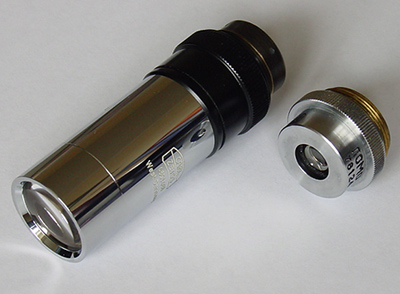
|
Notes
on using a very low power objective, the Zeiss plan 1x, on a LOMO microscope. by David Walker, UK |
|
The lowest power objective on my LOMO microscope is the maker's competent and affordable planachro 3.5x NA 0.10 (above right). However, with the standard 1.5x binocular head the field of view is about 3.5 mm (7x eyepieces) so there's many larger subjects where the 'bigger picture' can't be enjoyed to the full without scanning. So I've always had half an eye open for a lower power objective.
I do use a budget Meiji stereo with paired objectives 10x - 40x, but the lighting is so-so with its bullet shaped low wattage tungsten bulbs. The angled optics are also less than ideal for photography and the optics on a budget stereo in my view can't match that of a modest low power compound microscope objective.
An ultra low power compound microscope objective that's looked appealing when I've seen them come up on eBay is the Carl Zeiss 1x planachromatic N.A. 0.04 for 160 mm tube (above left). Examples seem to sell within a wide price range so when it's sold in three figures it's been outside my budget. But a recent good example didn't attract the usual eBay interest so was fortunate to acquire one for a few tenners and took a gamble that it may work on the LOMO.
I'm not a Zeiss aficionado so can't comment on its optical construction, what stand it was designed to be used on and maker's recommended illumination. So below are just 'hands on' observations of its use on the LOMO Biolam stand, although the general observations should apply to other stands on which it can be fitted.
Does it fit? The 1x is a big beastie at 5.8 cm from nosepiece to front housing (total length 6.7 cm, above left) and dwarfs other pre-DIN objectives. Fortunately the moving limb of the Biolam has quite a long travel and it does fit and can be focussed, albeit there's not much travel left before the upper coarse focus limit.
The optics extend ca. 8.5 mm into the nosepiece beyond objective's base so with the LOMO nosepiece it must be installed in the empty objective port along the optical axis as there's not enough nosepiece depth for it to swing round on the turret. This is not a problem in use as because of its size I can't envision wishing to have it installed permanently on a rotating nosepiece. (I'm not sure if this was also the case on Zeiss nosepieces, which may be deeper to accommodate rotation. Thank you to Paul James who tells me the turret depth on a Zeiss photomicroscope is ca. 11.2 mm cf the ca. 9 mm on my LOMO Biolam.)
Lighting:
This was anticipated to be a potential problem. Lighting my 3.5x objective evenly
to
photographic standards is not that easy so was envisaging all sorts of bodges
for the 1x with bulls eyes, diffusers etc to gain even lighting ... until
I went back to basics. Taking out the condenser entirely and using a 75W photoenlarger
bulb and plane mirror gives a visually even illumination across the objective's field
of view (below). These bulbs have almost unstructured even frosting and whiter
than domestic frosted bulbs so eminently suitable for low power illumination.
I have the bulb installed in a well ventilated metal desk lamp
that can take 75W, but it's never left unattended, it still gets a tad hot.
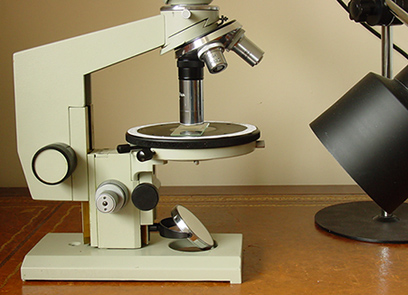
The
1x focussed on a LOMO Biolam stand. With the condenser out, using a plane
mirror
and photoenlarger bulb in a desk lamp, the lighting is good
for visual studies.
In use: It gives excellent flat crisp images with a field of view of 11.5 mm with K7x LOMO eyepieces and 1.5x bino head, c.f. a field of 3.5 mm with the 3.5x LOMO objective. As most subjects are usually within a 10 mm square coverslip, there's few subjects that can't be enjoyed 'whole'. It doesn't seem too fussy about eyepiece maker, the LOMO compensating eyepieces seem fine.
For some work, e.g. polar I often go back to a monocular tube, the loss of the 1.5x factor of the bino' head then extends the field of view to 16.5 mm with front section attached, giving excellent overviews of e.g. crystal subjects or the wider thin rock sections.
A colleague told me that the front section unscrews, which it indeed does, acting I believe as its own condenser. With the front section removed the enlarger bulb described fills about 90% of the field with concave mirror.
|
Objective |
Field
of view / mm |
Field
of view / mm |
Field
of view / mm |
|
LOMO 3.5x NA 0.10 |
3.5 |
5.1 |
3.7 x 2.5 |
|
Zeiss 1x NA 0.04 |
11.5 |
16.5 |
12 x 8 |
Fields
of view summary. (Note that the field no. of the LOMO e/piece is small at ca.
11.5 mm.
Modern
eyepieces with field nos. of 18+ may give very different fields of view).
Photography: Although the enlarger bulb gives a visually even field, photography is more discriminating, so evenly illuminating the field without Zeiss' appropriate condenser may be tricky. To obtain a focussable image at the 35 mm film plane the eyepiece had to be raised by ca. 19 mm. I also had trouble obtaining sharp photos despite the image in the SLR viewfinder (coarse screen with clear split image at centre) appearing sharp. I believe the lowest power objectives have the lowest depth of focus so focussing may be critical for a 1x; comments welcomed.
Below are scans of Ilford Pan F film.
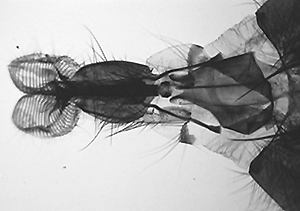
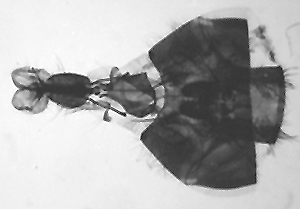
Left:
blowfly head, 3.5x objective (NBS slide). Right: same subject with 1x gives
the full subject - to give idea of field only,
a grim image as heavily
sharpened as out of focus. Somewhat uneven lighting with 1x and enlarger lamp.
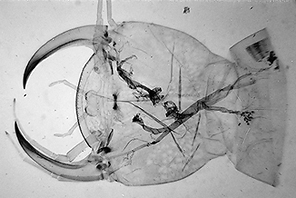
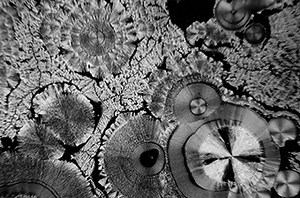
Left:
centipede head, 1x objective (NBS slide). Right: 1X objective, vitamin C slide
(Mike Samworth).
The large field of view of the 1x allows more 'landscape'
type images of polar subjects.
Is it a keeper? The extra visual field of view is certainly appealing, but the need to specifically install the objective for use then take it out immediately when using any other objective makes it less practical than anticipated .... on the LOMO stand at least, it may be more practical on the stand it was designed for! Photography looks as if it could be tricky; further work required! But for the present, the Zeiss 1x is a useful item in the 'optics box' (while I save up an awful lot of pennies for one of those rather splendid Wild M420 macroscopes!).
Comments to the author David Walker are welcomed.
Published in the June 2005 edition of Micscape.
Please report any Web problems or offer general comments to the Micscape Editor .
Micscape is the on-line monthly magazine of the Microscopy UK web site at Microscopy-UK
© Onview.net Ltd, Microscopy-UK, and all contributors 1995
onwards. All rights reserved.
Main site is
at www.microscopy-uk.org.uk
with full mirror
at www.microscopy-uk.net
.